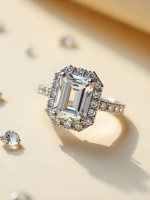Are lab diamonds real diamonds? Uncover the real differences in creation, cost, quality, and ethics – and why your next diamond purchase might change the industry forever.
In the recent decades there has been a sharp increase in the demand for lab grown diamonds globally. This phenomenon is driven by various factors such as the eco friendliness of lab grown diamonds and easier affordability, among other things. It is important that the difference between mined diamonds and lab grown diamonds is well understood by buyers so that they can make informed choices. Read on to understand this difference in terms of creation, quality, cost and ethics.
Lab grown diamonds vs. mined diamonds
|
Feature |
Lab-Grown Diamonds |
Mined Diamonds |
|---|---|---|
|
Origin |
Created in a laboratory |
Formed naturally deep within the Earth |
|
Creation Process |
Produced using advanced technology |
Formed over billions of years under high pressure and temperature |
|
Cost |
Generally more affordable |
Typically more expensive |
|
Environmental Impact |
More environmentally friendly |
Can have significant environmental impact due to mining |
|
Ethical Considerations |
Conflict-free and socially ethical |
Can be conflict-free if sourced responsibly |
|
Physical Properties |
Identical to mined diamonds in appearance |
Natural variations and unique history |
|
Identification |
Often laser-inscribed for identification |
Can be identified by gemologists |
1.How Lab Grown Diamonds Are Made
What does lab grown diamond mean? There are two ways of creating diamonds in a lab. High Pressure, High Temperature (HPHT) method and Chemical Vapor Deposition (CVD) method. Both these methods mimic the earth’s natural processes to create real gem quality diamonds in a lab.
In the CVD method a tiny fragment of diamond is put inside a carbon rich gas loaded chamber. The temperature of the chamber is really high so that in just a few weeks time the carbon ionization is complete and the new particles pile onto the tiny diamond fragment.
In the HPHT process carbon in its pure form is placed inside a metal box and then subjected to intense heat and pressure using electrical currents.
This makes the carbon eventually break down and crystallize as a diamond. In this method metal interference is very little and non noticeable by the human eye.
It is generally accepted that lab diamonds developed using the HPHT method are superior to CVD diamonds. CVD diamonds that grow fast come with internal spots and grains. Additionally, CVD diamonds need post growth treatment as they have a brown shade to them. HTHP diamonds need no such post growth treatment.
2.The Natural Creation of Mined Diamonds
Natural diamonds are formed as carbon atoms bond together under extreme pressure and heat conditions deep within the Earth. This pressure is mostly in excess of 50, 000 times the pressure at the surface and the temperatures are as high as 1400 degree celsius. This process can take billions of years to complete. It is hundreds of kilometers below the surface that diamonds are formed and it is when a part of this mantle melts into Magma and rises to the surface in eruptions that kimberlite rock is formed. This rock appears in vertical pipes called the kimberlite pipes from which the miners extract the diamond. It should be noted that natural diamonds are not only very rare but are the only known gemstones that are formed from a single element (Carbon). However, it should also be noted that mining of the natural diamond is highly detrimental to the environmental health of the planet and its communities in the following ways:
- Soil erosion
- Water pollution
- Greenhouse gas emissions
- Air pollution
- Habitat destruction
- Waste rock
- Ground-level ozone
- Upper ozone layer depletion
3.Quality Comparison
Lab-grown and mined diamonds are both real diamonds with the same chemical, physical, and optical properties. However, there are some comparisons between the two in terms of clarity, color, cut and certification standards.
When it comes to clarity, mined diamonds and lab diamonds both show certain inclusions. Mostly, Lab-grown diamonds have different types of inclusions than natural diamonds. For instance, HPHT synthetic diamonds often have inclusions from the nickel-iron-based flux used in the growth process, while CVD diamonds often have small black particles. Also, lab-grown diamonds have fewer types of inclusions than natural diamonds, and it's becoming rarer to find inclusions in synthetic diamonds.
Both lab-grown and mined diamonds can come in a variety of colors, and are graded using the same color scales. The GIA color grading scale has five categories: Colorless, Near Colorless, Faint, Very Light, and Light.
4.Ethical Considerations
Also known as blood diamonds, mined diamonds are often harvested in war zones and sold to fund violence and armed conflicts. The profits from selling these diamonds have caused human rights abuses and suffering in many areas.
Many diamond mines are located in developing countries with weak labor laws, which can lead to the exploitation of workers, including children. Lab-grown diamonds are produced in controlled environments, making it easier to ensure fair labor practices and eliminate the risk of supporting unethical mining operations. Lab-grown diamonds are not associated with the human rights issues and conflicts that plague the diamond industry.
5.Why lab grown diamonds are generally more affordable.
Lab-grown diamonds are more affordable as they are created in a controlled environment using advanced technology, which is more efficient than mining natural diamonds. Also, lab created diamonds are more affordable as they have a shorter supply chain because they skip the mining process.
Rings
Lab grown diamond rings are a fad these days. Diamond Chemistry offers various lab grown diamond rings for engagement.
- Solitaire Rings: Classic and timeless

- Side Stone Rings: Elegant with additional lab grown diamonds on the band

- Halo Rings: Surrounding the center stone with smaller diamonds for extra sparkle

- Hidden Halo Rings: Similar to halo rings but with a more subtle design

- Three Stone Rings: Symbolizing the past, present, and future




